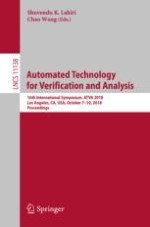This book constitutes the refereed proceedings of the 24th International Symposium on Automated Technology for Verification and Analysis, ATVA 2018, held in Los Angeles, CA, USA in October 2018.
The 27 full papers presented together with 5 short papers and 3 invited talks were carefully reviewed and selected from 82 submissions.
The symposium is dedicated to the promotion of research on theoretical and practical aspects of automated analysis, verification and synthesis by providing a forum for interaction between the regional and the international research communities and industry in the field.
